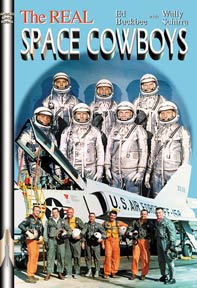|
|
Review: The Real Space Cowboys
by Jeff Foust
Monday, July 25, 2005
The Real Space Cowboys
by Ed Buckbee with Wally Schirra
Apogee Books, 2005
softcover, 168 pp., illus.
ISBN 1-894959-21-3
US$29.95/C$36.95
When does a book come with a bonus DVD and when does a DVD come with a bonus book? That may seem like an odd question, but in today’s multimedia world, where movies are both the inspiration for and inspired by videogames, it’s hardly an irrelevant one. Since Apogee Books started its line of space books in the late 1990s the company has included CD-ROMs, and now DVDs, with its books, containing additional documents, images, videos, and the like, tied to the subject of the book. These discs have always been intended to be ancillary products secondary to the book itself. However, The Real Space Cowboys may be one of the first cases where the disc outshines the book itself.
Buckbee, the principal author of the book, has a long history with the space program and its early astronauts. He joined NASA in the late 1950s and a few years later went to Marshall Space Flight Center as a public affairs officer, where in that capacity he got to know the astronauts as well as the legendary Wernher von Braun. In 1970 von Braun picked Buckbee to be the first director of the US Space and Rocket Center; Buckbee later went on to co-found Space Camp there.
That background certainly makes Buckbee well-qualified to write about the early history of the American space program, and the mix of personalities—those so-called “real space cowboys”—who helped shape it. However, the book itself is disappointing: rather than a cohesive narrative about the Space Race, or the story of his own role in the effort to send men to the Moon, Buckbee instead offers a disjointed series of profiles of the Mercury Seven astronauts, other key people like von Braun and John F. Kennedy, and other vignettes from early NASA history. Although the chapters are based in large part on primary source materials, including interviews with and panels featuring the Mercury Seven, the book offers few new insights into the astronauts and their roles in the space program beyond some humorous anecdotes. The book includes dozens of pictures, but many of them are of Buckbee himself posing with people ranging from Dinah Shore and David Letterman to Al Gore and Arnold Schwarzenegger.
| Although the chapters are based in large part on primary source materials, the book offers few new insights into the astronauts and their roles in the space program beyond some humorous anecdotes. |
If all The Real Space Cowboys had to offer was the book itself, it would be a disappointment to most readers, particularly those already familiar with the people and history of the early American space program. But there is that disc ticked into the inside back cover, in this case a double-sided DVD. The DVD contains a fascinating collection of videos, ranging from old documentaries about the Mercury Seven astronauts and von Braun to recordings of panels featuring former astronauts (including one that included a rare public appearance by Neil Armstrong) to some of the “gotcha” gag movies that the astronauts made to poke fun at each other. Many of these videos are mentioned in the text of the book, although their presence on the DVD is not explicitly noted.
Unfortunately, the DVD is treated as an add-on and not integrated into the book as well as desired: including a lack of references to the DVD in the text of the book, the only mention of the contents of the book comes on a single page at the back of the book, which lists very brief descriptions of what is on the DVD, but doesn’t offer more details, or even on what side of the DVD each video is on. The menu screens of the DVD itself are not only not quite as slick as those for Hollywood movies, but offer only cryptic descriptions of the contents.
Despite these problems, the DVD is perhaps the best reason to get The Real Space Cowboys. If you’re interested in some historic videos from the early Space Age that are otherwise difficult to find, the book’s DVD makes up for the relatively lackluster content of the book itself.
Jeff Foust (jeff@thespacereview.com) is the editor and publisher of The Space Review. He also operates the Spacetoday.net web site and the Space Politics weblog. Views and opinions expressed in this article are those of the author alone, and do not represent the official positions of any organization or company, including the Futron Corporation, the author’s employer.
|
|
